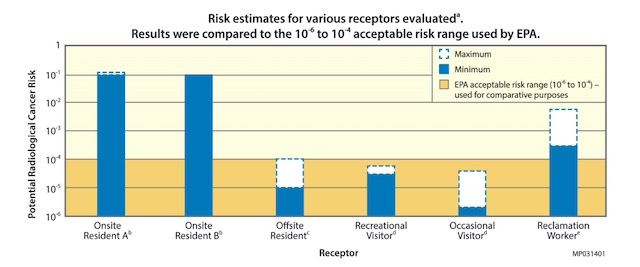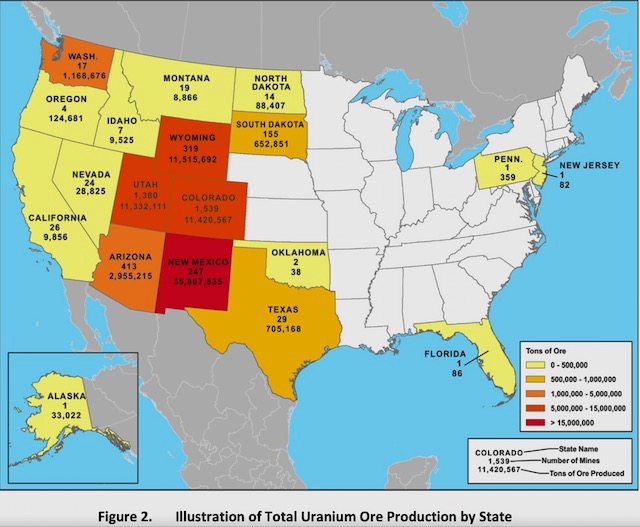Department Of Energy Report To Congress Casually Mentions Huge Unaddressed Risks
Over $800 BILLION Military Budget, But No Funds For Abandoned Uranium Mine Cleanup
I’ve been reading government environmental documents and risk assessments for 5 decades now, and I don’t recall ever reading one like the US Department of Energy’s 2014 Report to Congress on the risks of abandoned uranium mines that served the US military’s nuclear weapons program, including the obscurantist title, see:
I happened upon this Report upon reading a devastating essay this morning. The essay objected to the “Oppenheimer” film and had a very clear title, please read it:
I am ashamed to admit that I knew very little about most of this “legacy” (despite having read the superb book “American Prometheus” that spurred the movie and having been roaming the southwest for the last 7 years in precisely the landscape of this legacy.)
Disgusted, I felt obligated to chase some links and learn about what was going on. I began with this 2014 DoE Report to Congress.
It is an astonishingly superficial and casual 20 page Report – bordering on negligence and coverup – particularly given the appallingly high cancer risks of 1 in 10 to nearby residents (consider that the next time some Democratic Party hack or faux climate activists tells you that no one ever died from nuclear power).
For context, NJ law establishes a 1 in a million cancer risk. The abandoned uranium mines pose a cancer risk 100,000 times greater. US EPA policy sets a risk range of 1 in ten thousand to 1 in a million. So this 1 in 10 risk is just astonishing and how DoE addresses it is simply scandalous.
My small group at DEP did more thorough work in 1985 documenting the risks from chemical plants. These were, by design, cursory reviews known as “Preliminary Assessments” (the first screening step in the remedial process).
The DoE Report found at least 4,225 abandoned mines, mostly in southwestern states, many on the lands of indigenous people and impacting the health of Native American people:
Despite estimating incredibly high cancer risk findings, the Report fails to provide the specific locations of these mines so that impacted people and communities could be warned and empowered to demand remedial actions.
The Report makes other astonishing findings, including the fact that: 1) the cleanup (reclamation and remediation) of these hazardous abandoned mines is not regulated; 2) there are no health based radiological cleanup standards; 3) there are enormous gaps in existing federal environmental mine related and remedial programs; 4) there are totally inadequate funds to cleanup and no funding source; and 5) implicitly, by omission, there is a serious lack of community awareness and involvement in cleanup.
In general, mines that provided ore to the AEC operated under provisions of the General Mining Law of 1872, as amended, under which there were no requirements for reclamation or remediation of mines when operation of them ended. As a consequence, many of them were left in an uncontrolled state
The Report also found a pattern of bureaucratic negligence, neglect, and lack of followup, even at US EPA:
EPA prepared a Report to Congress in 1983; the report made recommendations for regulations to control wastes and air emissions at uranium mines but did not request congressional action for a new remedial action program. In a similar report in 1985, EPA expressed concern that mine wastes may pose a threat to human health and the environment, but that EPA did not have enough information to conclude they do.
I need to do additional research – in the meantime, I urge you to read the Report.
[Update: Correction: I can’t say “no funds”. US DoE has a legacy mines program. Need to read up on that. But it looks like all they’ve done since the 2014 Report to Congress is conduct “field visits” at about 90% of the sites, with completion expected in 2024. That’s not even the first step of “preliminary assessment” in the remedial process. Here is the most recent “progress report” (2022) – cool maps, but not much happening.
And it looks like they’ve done little and virtually no cleanup work on tribal and Navajo Nation lands:
In 2022, the DRUM program began V&V work on its tribal land campaign. The DRUM team developed a cooperative agreement with the Pueblo of Laguna in New Mexico to support and plan for V&V work. DRUM personnel conducted and completed V&V work at mines on Pueblo of Laguna land in August. The DRUM team developed an additional cooperative agreement with the Navajo Nation for their assistance with public outreach, operational planning, V&V work, and future safeguarding tasks. After many months of planning and collaborating with the Navajo Nation and other agency counterparts, LM began V&V work at mines on the Navajo Nation in October. In June, LM completed the work to assess the future resource needs and to make recommendations for future V&V activities on Spokane Tribe of Indians land.
But despite this, the Biden Secretary of Energy thinks they are doing great:
On January 18, 2023, LM was notified that the DRUM Program received the Secretary of Energy Achievement Award for work completed in 2022. According to the notice, “These awards are among the highest forms of internal, non-monetary recognition DOE Federal and contractor employees can receive.” This is the first time an LM program or project has ever received this award. ~~~ end update]
And please support the work of “Cleanup The Mines”, who are seeking
passage of the Uranium Exploration and Mining Accountability Act, which will ensure clean up of thousands of hazardous abandoned uranium mines throughout the United States.


